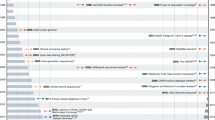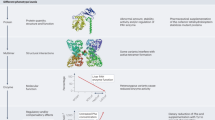Abstract
The use of DNA variants in the mapping of the human genome and in the positional cloning of monogenie disease genes is well established. Determining the genetic bases of the more common “multifactorial” diseases, however, presents a major challenge. The genetics of these diseases are complicated by the interplay between many genes and the environment. These investigations will require large numbers of DNA markers and the technology to screen large populations with these markers. The systematic identification of the common DNA polymorphisms in the human genome coupled with the development of high throughput screening methods should allow ultimately the elucidation of the genetic component of most clinical and nonclinical phenotypes.
This is a preview of subscription content, access via your institution
Access options
Subscribe to this journal
Receive 12 print issues and online access
$209.00 per year
only $17.42 per issue
Buy this article
- Purchase on Springer Link
- Instant access to full article PDF
Prices may be subject to local taxes which are calculated during checkout
Similar content being viewed by others
References
Landsteiner, K., 1900. Kenntnis der antifermentativen, lytischen und agglutinierended Wikungen des Blutserums und der Lymphe. Zbl. Bakt. 27: 357–362.
Yamamoto, R, Clausen, H., White, T., Marken, J., and Hakomori, S. 1990. Molecular genetic basis of the histoblood group ABO system. Nature 345: 229–233.
Smithies, O. 1957. Variations in human serum β-globins Nature 180: 1482–1483
Southern, E.M. 1975. Detection of specific sequences among DNA fragments separated by gel electrophoresis. J. Mol. Biol. 98: 503–517.
Jeffreys, A.J. 1979. DNA sequence variants in the G-γ -, Aγ-, δ- and β-globin genes of man. Cell 18: 1–10.
Cooper, D.N., Smith, B.A., Cooke, H.J., Niemann, S., and Schmidtke, J. 1985. An estimate of unique DNA sequence heterozygosity in the human genome. Hum. Genet. 69: 201–205.
Jeffreys, A.J., Wilson, V., and Thein, S.L. 1985. Hypervariable ‘minisatellite’ regions of human DNA. Nature 314: 67–73.
Nakamura, Y., Leppert, M., O'Connell, P., Wolff, R., Holm, T., Culver, M., et al. 1987. Variable number of tandem repeat (VNTR) markers for human gene mapping. Science 235: 1616–1622.
Weber, J.L. and May, P.E. 1989. Abundant class of human DNA polymorphisms which can be typed using the polymerase chain reaction. Am. J. Hum. Genet. 44: 388–396.
Lander, E.S. and Schork, N.J. 1994. Genetic dissection of complex traits. Science 265: 2037–2048.
Mohr, J. 1954. A. study of linkage in man. Opera ex Domo Biologiae Hereditariae Humanae Universitatis Hafniensis, vol. 33. Munksgaard, Copenhagen.
Botstein, D., White, R.L., Skolnick, M., and Davis, R.W. 1980. Construction of a genetic linkage map in man using restriction fragment length polymorphisms. Am. J. Hum. Genet. 32: 314–331.
Ott, J. 1991. Analysis of human genetic linkage (Revised Edition). The Johns Hopkins Press, Baltimore, MD.
Penrose, L.S. 1935. The detection of autosomal linkage in data which consists of pairs of brothers and sisters of unspecified parentage. Ann. Eugen. 6: 133–138.
Suarez, B.K., Rice, J., and Reich, T. 1978. The generalized sib pair IBD distribution: its use in the detection of linkage. Ann. Hum. Genet. 42: 87–94.
Risch, N. 1990. Linkage strategies for genetically complex traits :ll. The power of affected relative pairs. Am. J. Hum. Genet. 46: 229–241.
Bishop, D.T. and Williamson, J.A. 1990. The power of identity-by-state methods for linkage analysis. Am. J. Hum. Genet. 46: 254–265.
Taylor, T.D., Litt, M., Kramer, P., Pandolfo, M., Angelini, L., Nardocci, N., et al. 1996. Homozygosity mapping of Hallervorden-Spatz syndrome to chromosome 20p12.3–p13. Nat. Genet. 14: 479–481.
Ellis, N.A., Groden, J., Ye, T.Z., Straughen, J., Lennon, D.J., Ciocci, S., Proytcheva, M. and German, J. 1995. The Blooms-syndrome gene-product is 46, homologous to recQ helicases. Cell 83: 655–666.
Davies, J.L., Kawaguchi, Y., Bennett, S.T., Copeman, J.B., Cordell, H.J., Pritchard, L.E., et al. 1994. A genome-wide search for human type 1 diabetes susceptibility genes. Nature 371: 130–136.
Cordell, H.J. and Todd, J.A. 1995. Multifactorial inheritance in type 1 diabetes. Trends Genet. 11: 499–504.
Riordan, J.R., Rommens, J.M., Kerem, B., Alon, N., Rozmahel, R., et al. 1989. Identification of the cystic fibrosis gene: cloning and characterization of complementary DNA. Science 245: 1066–1073.
Yu, S., Pritchard, M., Kremer, E., Lynch, M., Nancarrow, J., Baker, E., et al. 1991. Fragile X genotype characterized by an unstable region of DNA. Science 252: 1179–1181.
Verkerk, A.J., Pieretti, M., Sutcliffe, J.S., Fu, Y.H., Kuhl, D.P., Pizzuti, A., et al. 1991. Identification of a gene (FMR-1) containing a CGG repeat coincident with a breakpoint cluster region exhibiting length variation in fragile X syndrome. Cell 65: 905–914.
The Huntington's Disease Collaborative Research Group. 1993. A novel gene containing a trinucleotide repeat that is expanded and unstable on Huntingtons-disease chromosomes. Cell 72: 971–983.
Weeks, D.E. and Lathrop, G.M. 1995. Polygenic disease: methods for mapping complex disease traits. Trends Genet. 11: 513–519.
Sawcer, S., Jones, H.B., Feakes, R., Gray, J., Smaldon, N., Chataway, J., et al. 1996. A genome screen in multiple-sclerosis reveals susceptibility loci on chromosome 6p21 and 17q22. Nat. Genet. 13: 464–468.
Haines, J.L., Ter-Minassian, M., Bazyk, A., Gusella, J.F., Kim, D.J., Terwedow, H., et al. 1996. A complete genomic screen for multiple sclerosis underscores a role for the major histocompatability complex. Nat. Genet. 13: 469–471.
Moldin, S.O. 1997.The maddening hunt for madness genes. Nat. Genet. 17: 127–129.
Collins, F.S. 1995. Positional cloning moves from perditional to traditional Nat. Genet. 9: 347–350.
Nelson, D.L. 1995. Positional cloning reaches maturity. Curr. Opin. Genet. Dev. 5: 298–303.
Owen, M.J. and McGuffin, P. 1993. Association and linkage: complementary strategies for complex disorders. J. Med. Genet. 30: 638–639.
Schlosstein, L., Terasaki, J.I., Bluestone, R., and Pearson, C.M. 1973. High association of an HLA antigen, W27, with ankylosing spondylitis. N. Engl. J. Med. 288: 704–706.
Brewerton, D.A., Caffrey, M., Hart, F.D., James, D.C.D., Nicholls, A., and Sturrocj, R.D. 1973. Ankylosing spondylitis and HLA 27. Lancet 1: 904–907.
Strittmatter, W.J., Saunders, A.M., Schmechel, D., Pericak-Vance, M., Enghild, J., Salvesen, G.S. and Roses, A.D. 1993. Apolipoprotein-e high-avidity binding to beta-amyloid and increased frequency of type-4 allele in late-onset familial Alzheimer-disease. Proc. Natl. Acad. Sci. USA 90: 1977–1981.
Saunders, A.M., Strittmatter, W.J., Schmechel, D., St George-Hyslop, P.H., Pericak-Vance, M.A., Joo, S.H. et al. 1993. Association of apolipoprotein-e allele epsilon-4 with late-onset familial and sporadic Alzheimer's-disease. Neurology 43: 1467–1472.
Jorde, L.B. 1995. Linkage disequilibrium as a gene-mapping tool. Am. J. Hum. Genet. 56: 11–14.
Curtis, D. 1997. Use of siblings in case-control association studies. Ann. Hum. Genet. 61: 319–333.
Spielman, R.S.R.E., McGinnis, R.E, and Ewens, W.J. 1993. Transmission test for link-age disequilibrium: the insulin gene region and insulin-dependent diabetes mellitus (IDDM). Am. J. Hum. Genet. 52: 506–516.
Schaid, D.J., Sommer, S.S. 1994. Comparison of statistics for candidate-gene association studies using cases and parents. Am. J. Hum. Genet. 55: 402–409.
Spielman, R.S. and Ewens, W.J. 1996. The TDT and other family-based tests for linkage disequilibrium and association. Am. J. Hum. Genet. 59: 983–989.
Langefeld, C.D., Pericak-Vance, M.A., Saunders, A.M., and Boehnke, M. Family-based tests for association using discordant sib pairs. Am. J. Hum. Genet. 61S:1643.
Ewens, W.J. and Spielman, R.S. 1997. The sib-TDT (S-TDT): a TDT (transmission/disequilbrium test) without parents. Am. J. Hum. Genet. 61S:1600.
Kruglyak, L. 1997. The use of a genetic map of biallelic markers in linkage studies. Nat. Genet. 17: 21–24.
Grompe, M. 1993. The rapid detection of unknown mutations in nucleic acids. Nat. Genet. 5: 111–117.
Mashal, R.D. and Sklar, J. 1996. Practical methods of mutation detection. Curr. Opin. Genet. Dev. 6: 275–280.
Hawkins, J.R. 1997. Finding mutations. IRL Press at Oxford University Press.
Cotton, R.G.H. 1997. Mutation detection. Oxford University Press.
Hayashi, K. and Yandell, D.W., 1993. How Sensitive Is PCR-SSCP? Hum. Mutat. 2: 338–346.
Naylor, J.A., Green, P.M., Rizza, C.R. and Giannelli, F. 1993. Analysis of factor VIII mRNA reveals defects in every one of hemophilia A patients. Hum. Mol. Genet. 2: 11–17.
Roberts, R.G. Bobrow, M., and Bentley, D.R. 1992. Point mutations in the dystrophin gene. Proc. Natl. Acad. Sci. USA. 89: 2331–2335.
Khurshid, F. and Beck, S. 1993. Error analyisis in manual and automated DNA sequencing. Anal. Biochem. 208: 138–143.
Shumaker, J.M., Metspalu, A., and Caskey, C.T. 1996. Mutation detection by solid-phase primer extension. Hum. Mutat. 7: 346–354.
Pastinen, T., Kurg, A., Metspalu, A., Peltonen, L., and Syvanen, A.C. 1997. Minisequencing—a specific tool for DNA analysis and diagnostics on oligonucleotide arrays. Genome Res. 7: 606–614.
Hoheisel, J.D. 1997. Oligomer-chip technology. Trends Biotechnol. 15: 465–469.
Editorial. 1996. To affinity… and beyond! Nat. Genet. 14: 367–370.
Joyner, A. (ed.) 1993. Gene Targeting. A practical approach. Oxford University Press.
Russell, W.L., Kelly, E.M., Hunsicker, P.R., Bangham, J.W., Maddux, S.C., and Phipps, E.L. 1979. Specific-locus test shows ethylnitrosourea to be the most potent mutagen in the mouse. Proc. Natl. Acad. Sci. USA, 76: 5818–5819.
Wilmut, I., Schnieke, A.E., McWhir, J., Kind, A.J., and Campbell, K.H.S. 1977. Viable offspring derived from fetal and adult mammalian cells. Nature 385: 810–813.
Orita, M., Iwahana, H., Kanazawa, H., Hayashi, K., and Sekiya, T. 1989. Detection of polymorphisms of human DNA by gel electrophoresis as single-strand conformation polymorphisms. Proc. Natl. Acad. Sci. USA 86: 2766–2770.
White, M.B., Carvalho, M., Derse, D., O'Brien, S.J., and Dean, M. 1992. Detecting single base substitutions as heteroduplex polymorphisms. Genomics 12: 301–306.
Fischer, S.G. and Lerman, L.S. 1983. DNA fragments differing by single base pair substitutions are separated in denaturing gradient gels: correspondence with melting theory. Proc. Natl. Acad. Sci. USA 80: 1579–1583.
Riesner, D., Steger, G., Zimmat, R., Owens, R.A., Wagenhöfer, M., Hillen, W., et al. 1989. Temperature-gradient gel electrophoresis of nucleic acids: analysis of conformational transitions, sequence variations, and protein-nucleic acid interactions. Electrophoresis 10: 377–389.
Myers, R.M., Larin, Z., and Maniatis, T. 1985. Detection of single base substitu-tions by ribonuclease cleavage at mismatches in RNA:DNA duplexes. Science 230: 1242–1246.
Rowley, G., Saad, S., Giannelli, F., and Green, P.M. 1995. Ultrarapid mutation detection by multiplex, solid-phase chemical cleavage. Genomics 30: 574–582.
Roberts, E., Deeble, V.J., Woods, C.G., and Taylor, G.R. 1997. Potassium-permanganate and tetraethylammonium chloride are a safe and effective substitute for osmium-tetroxide in solid-phase fluorescent chemical cleavage of mismatch. Nucl. Acids Res. 25: 3377–3378.
Youil, R., Kemper, B., and Cotton, R.G.H. 1996. Detection of 81 of 81 known mouse beta-globin promoter mutations with T4 endonuclease-VII—the EMC method. Genomics 32: 431–435.
Smith., J. and Modrich, P. 1996. Mutation detection with MutH MutL, and MutS mismatch repair proteins. Proc. Natl. Acad. Sci. USA 93: 4374–4379.
Underhill, P.A., Jin, L., Zemans, R., Oefner, P.J., and Cavalli-Sforza, L.L. 1996. A pre-Columbian Y-chromosome-specific transition and its implications for human evolutionary history. Proc. Natl. Acad. Sci. USA 93: 196–200.
Roskey, M.T., Juhasz, P., Smirnov, I.P., Takach, E.J., Martin, S.A., and Haff, L.A. 1996. DNA sequencing by delayed extraction-matrix-assisted laser desorption/ionization time of flight mass spectrometry. Proc. Natl. Acad. Sci. USA 93: 4724–4729.
Livak, K.J., Marmaro, J. and Todd, J.A. 1995. Towards fully automated genome-wide polymorphism screening. Nat. Genet. 9: 341–342.
Pease, A.C., Solas, D., Sullivan, E.J., Cronin, M.T., Holmes, C.P, Fodor, S.P.A. 1994. Light-generated oligonucleotide arrays for rapid DNA-sequence analysis. Proc. Nat/. Acad. Sci. USA 91: 5022–5026.
Author information
Authors and Affiliations
Corresponding author
Rights and permissions
About this article
Cite this article
Schafer, A., Hawkins, J. DNA variation and the future of human genetics. Nat Biotechnol 16, 33–39 (1998). https://doi.org/10.1038/nbt0198-33
Received:
Accepted:
Issue Date:
DOI: https://doi.org/10.1038/nbt0198-33
This article is cited by
-
Association between SSR markers and fibre traits in sea island cotton (Gossypium barbadense) germplasm resources
Journal of Genetics (2017)
-
Single nucleotide polymorphism detection by optical DNA-based sensing coupled with whole genomic amplification
Analytical and Bioanalytical Chemistry (2013)
-
Identification of associations between SSR markers and fiber traits in an exotic germplasm derived from multiple crosses among Gossypium tetraploid species
Theoretical and Applied Genetics (2009)
-
Analysis of mismatched DNA by mismatch binding ligand (MBL)–Sepharose affinity chromatography
Analytical and Bioanalytical Chemistry (2007)
-
Dissecting the architecture of a quantitative trait locus in yeast
Nature (2002)



